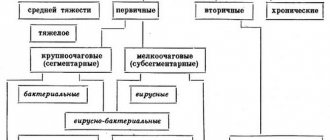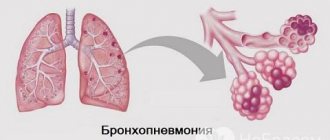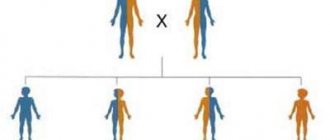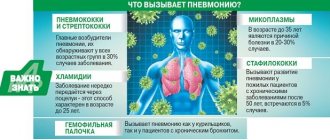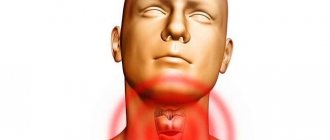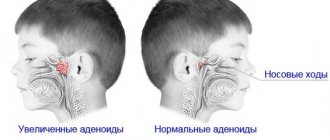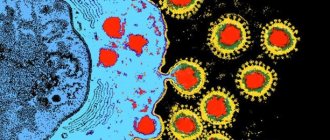Atypical pneumonia: symptoms in children and adults, treatment.
The term “atypical pneumonia” appeared in the 30s of the twentieth century.
It was proposed to designate diseases that develop not from pneumococci, but for other reasons.
To identify them, other diagnostics and treatment are used.
- Causative agents of atypical pneumonia
- Features of atypical pneumonia
- Symptoms of SARS
- Diagnosis of atypical pneumonia
- Treatment of atypical pneumonia
- Prognosis for atypical pneumonia
Causative agents of atypical pneumonia
Atypical pneumonia develops if an atypical pathogen - bacteria, fungi, viruses - enters the body.
The type of parasite determines the clinical picture of the disease.
The most common atypical pathogens:
| Pathogen name | Peculiarities |
| Chlamydia pneumoniae | Mild form of pneumonia with mild symptoms |
| Chlamydia psittaci | Ornithosis pneumonia |
| Coxiella burnetii | Q fever |
| Francisella tularensis | Tularemia pneumonia |
| Legionella pneumophila | Legionellosis, or Legionnaires' disease. It is difficult to tolerate and is characterized by high mortality (second place after pneumococcal diseases in terms of mortality - 8–39%). More often affects older adults |
| Mycoplasma pneumoniae | Most often it affects young people. Sometimes accompanied by neurological and systemic manifestations, such as skin rashes |
Viral SARS is caused by:
- adenovirus;
- influenza A and B virus;
- measles virus, etc.
- parainfluenza virus;
- SARS (severe acute respiratory syndrome) virus, or SARS;
- human respiratory syncytial virus, or RSV;
- cytomegalovirus.
Types of disease
Classification of diseases by pathogen allows us to distinguish the following forms of pulmonary pneumonia:
Classification of pneumonia
- mycoplasma;
- Q fever;
- chlamydial;
- acute respiratory syndrome;
- interstitial pneumonia.
Mycoplasma pneumonia is recorded in 20% of cases in children and 3% in adults.
Epidemiological foci arise in places of greatest concentration and constant presence of people: work shops, office premises, kindergartens, schools, etc.
Atypical mycoplasma pneumonia
Respiratory mycoplasmosis is an inflammation of the upper or lower respiratory tract, manifested as nasopharyngitis, tracheitis, bronchitis and atypical pneumonia. The disease, not burdened by complications, occurs in a mild or moderate form. After the end of the incubation period (7–14 days), a prodromal period begins, accompanied by increased dryness of the upper respiratory tract, sore throat, and dry cough. The temperature does not rise above 38 °C. In 1/3 of cases, bilateral pneumonia is diagnosed.
Complications of mycoplasma pneumonia:
A complication of mycoplasma pneumonia is bronchitis
- bronchitis;
- bronchiolitis;
- pneumosclerosis.
Features of atypical mycoplasma pneumonia:
- Inconsistency between the examination data and the results of the X-ray analysis.
- Ineffectiveness of treatment with penicillins and cephalosporins.
Changes in the main respiratory sounds occur on days 3–5 and are accompanied by weakening of breathing and the absence of moist rales.
It is possible to establish an accurate diagnosis of the disease using 2-plane radiography of the lungs and laboratory methods:
- bacteriological culture of sputum;
- radioimmunoassay;
- ELISA, RSK, etc.
Sputum examination
In the treatment of mycoplasma pneumonia use:
| A drug | Photo | Price |
| Erythromycin | from 13 rub. | |
| Clindamycin | from 170 rub. | |
| Azithromycin | from 104 rub. | |
| Lincomycin | from 95 rub. |
The main course of therapy lasts up to 7 days, and then, as the symptoms weaken, an additional course of treatment is established.
Features of atypical pneumonia
The mechanism of how intracellular parasites cause pneumonia is not yet fully understood.
But it is known that under the influence of the pathogen, the lungs become inflamed, oxygen access is blocked, against which characteristic symptoms develop.
Atypical pneumonia has a number of features, namely:
- traditional treatment - sulfonamides and beta-lactam antibiotics, which are widely used for common forms of pneumonia, are ineffective;
- the prevalence of inflammation is low, so there is no healing of the lung tissue. But if the process progresses, lobar pneumonia sometimes develops;
- leukocytosis (increased number of leukocytes - white blood cells that protect the body from pathogens) is either absent or weakly expressed;
- there is little or no sputum discharge;
- relatively little exudate accumulates in the alveoli - effusion from blood vessels;
- It is difficult to determine the severity of his condition by the patient’s appearance: as a rule, he looks better.
Symptoms of SARS
What the signs of atypical pneumonia will be depends on the pathogen.
Mycoplasma pneumonia: symptoms
The incubation period lasts 3–11 days. The infection is transmitted by airborne droplets.
Infection occurs through prolonged close contact: in adults - for example, in barracks, in children - in classrooms, etc.
Respiratory mycoplasmosis (another name) causes a sore throat and sore throat.
The cough is paroxysmal, accompanied by scant sputum production or dry, the throat is red.
The infection is accompanied by a runny nose and lacrimation.
The patient's body temperature rises, increased sweating is observed, weakness, headache, pain in the abdomen and joints appear.
The cervical lymph nodes and tonsils become enlarged, the mucous membrane of the eye turns red, and lacrimation occurs.
A number of patients also experience other symptoms - skin rashes on different parts of the body, nosebleeds, and complaints of pain in the heart.
Chlamydial pneumonia: symptoms
Atypical chlamydial pneumonia
The incubation period lasts 6–17 days. Chlamydia is transmitted by airborne droplets, possibly after contact with birds - pigeons, poultry, parrots, etc.
Recently, the incidence rate has been increasing.
Chlamydial pneumonia most often affects young people under the age of 25.
Pneumochlamydia begins acutely, accompanied by signs of general toxicity and an increase in body temperature.
The patient complains of severe headache, pain in muscles and joints, and chest pain.
A dry cough occurs, shortness of breath appears, and later sputum comes out - mucopurulent.
As in the previous case, the cervical lymph nodes, liver and spleen enlarge. Wheezing – scattered, muffled.
An X-ray image shows an increase in the pulmonary pattern; infiltration is not always detected.
Along with the described manifestations, a runny nose, sore throat, and nosebleeds may develop.
A person suffers the most severe illness if the causative agent is Chlamydia psittaci (chlamydia psittaci).
Legionnaires' disease: symptoms
The incubation period lasts 2–10 days. A person becomes infected when he inhales water aerosols - in the shower or bath.
Sources of spread of the disease can be air conditioners, water sprays, all kinds of humidifiers, fountains, etc.
The disease is not transmitted from one person to another.
With this form of pneumonia, other organs are often affected - the central nervous system, gastrointestinal tract, the liver becomes enlarged, kidney failure occurs, etc.
The temperature rises to 40 degrees and is accompanied by chills and aches, lasting 4-5 days. Breathing is difficult.
When you cough, sputum mixed with blood is released from the respiratory tract.
The patient complains of pain in the chest and abdomen, nausea, vomiting, and diarrhea.
In severe cases, gait and speech are impaired, and there are fainting and hallucinations.
The image shows typical foci of infiltration, which in 70% of cases then unite and occupy the entire lobe of the organ.
A blood test diagnoses leukocytosis, lymphopenia, a neutrophil shift to the left, an increase in ESR, as well as hyponatremia, hyperbilirubinemia, and hypoalbunemia.
Viral atypical pneumonia, SARS
It is this disease that has been called “atypical pneumonia” since 2002.
The causative agent, coronavirus, has not yet been studied, and was not known until the beginning of the 2000s.
The disease was first reported in China. 800 people around the world have died from coronavirus infection in just 8 months.
The high mortality rate is due to constant mutations of the virus, which makes it impossible to find a universal cure.
The virus is contained in the feces and biological fluids (saliva, sputum) of the patient.
A person becomes infected mainly through airborne droplets and the fecal-oral route.
It is noteworthy that the pathogen primarily affects adults aged 25–70 years.
Atypical pneumonia is rare in children.
Atypical pneumonia (SARS virus), phases
| Phase | Symptoms | Duration |
| Incubation period | 2–10 days | |
| First | temperature from 38 degrees; aches, chills, headache; cough without sputum | 3–7 days |
| Second | the severity of respiratory symptoms increases; breathing becomes difficult, shortness of breath appears; high body temperature persists | 4–7 days |
| Third | the temperature may rise again; cough and shortness of breath intensify; the stool becomes watery; swelling and respiratory failure develop in the lungs; the condition requires artificial ventilation. | Starts from 8–9 days |
In younger children, SARS symptoms do not appear as clearly as in adolescents and disappear earlier.
The X-ray picture returns to normal in a shorter period.
SARS pneumonia is characterized by a decrease in the level of leukocytes and platelets, and an increase in the level of liver enzymes.
X-ray shows infiltrates on the periphery of the lung.
On auscultation, fine bubbling rales and crepitus are heard (the sound resembles the noise of rubbing hair with fingers), the percussion sound is dull.
Etiology
There are several varieties of this pathology, which differ in the causative agent and their symptoms. In particular, the most common variant of this pathology is chlamydial atypical pneumonia, which, accordingly, is caused by chlamydia.
In the human body, chlamydia can live for a long time and not manifest itself in any way. But when favorable conditions are created for its reproduction, rapid growth of colonies of microorganisms occurs, with the development of inflammatory processes in various organs, including the lungs. Such a favorable condition is a decrease in immunity due to various reasons.
The second microorganism, which also often causes pathology such as atypical pneumonia, is mycoplasma. Mycoplasma pneumonia has mild symptoms and a milder course, but sometimes, when a person’s immunity is reduced, the disease can occur with severe symptoms and cause a serious condition for the patient.
The next microorganism that leads to the occurrence of this disease is Legionella. Legionella pneumonia is a serious disease that often affects older people. The pathogen is a gram-negative anaerobe, and it often lives in water supply and air conditioning systems, so you can become infected with the Legionella form in various public places.
A separate type is atypical pneumonia caused by coronavirus. This pathogen is transmitted by airborne droplets, but household infection also occurs, since in a favorable environment the virus can remain viable for 6 hours.
Predisposing factors that contribute to a decrease in the body's protective functions and the creation of favorable conditions for the introduction of coronovirus or other microorganisms that cause atypical pneumonia are:
- smoking;
- exposure to constant stress;
- a history of chronic renal failure and other chronic pathologies;
- decreased immunity due to taking antibacterial drugs, etc.
Diagnosis of atypical pneumonia
The main method for detecting pneumonia is chest x-ray.
Atypical pneumonia on x-ray
Inflammation on an x-ray may be noticeable even before SARS symptoms first appear.
At the same time, some forms of pneumonia with an atypical pathogen, for example, Pneumocystis, develop against the background of immunodeficiency, so radiography in this case is not very informative.
Then a computed tomography scan is prescribed.
The doctor conducts a general examination of the patient's chest, skin, lymph nodes, auscultation of the lungs, listening to wheezing.
Taking an anamnesis is important. So, in a conversation it may turn out that the patient has been in contact with a large number of people for a long time, raises poultry, or has recently returned from exotic countries where an outbreak of SARS was recorded.
A blood test is performed to help track characteristic changes.
Analysis of sputum in identifying the pathogen is ineffective, since mycoplasma, legionella, and chlamydia settle inside the cells of the body and are not excreted with sputum.
To determine the atypical pathogen and coronavirus, the following study is carried out:
- serological reactions - antibodies to the pathogen are detected in the blood;
- polymerase chain reaction - detects pathogen particles in the human body;
- inoculation of nasopharyngeal swabs and sputum onto nutrient media.
Therapy methods
The main principle of disease therapy is the fight against the pathogen. Taking into account the etiology of the disease, antibacterial or antiviral drugs are used for this. Antibiotics are selected taking into account the results of a sputum test to identify the pathogen and determine sensitivity to medications. Use drugs of the tetracycline, penicillin, fluoroquinolone or macrolide groups (Azithromycin, Tetracycline, Doxycycline, Levofloxacin, Erythromycin). The latter can be used for pregnant women and children. If the disease is caused by viruses, drugs with antiviral activity are used - Ribavirin, Relenza, Tamiflu. The medication, dosage and duration of treatment are selected by the doctor, taking into account the characteristics of the disease and the patient’s condition. The duration of therapy varies from 1 to 2 weeks.
For symptomatic treatment of the disease use:
- antipyretic drugs;
- agents with expectorant and mucolytic effects (to improve mucus discharge);
- bronchodilators to relieve bronchospasms;
- anti-inflammatory medications (steroidal and non-steroidal drugs);
- physiotherapy (inhalations, magnetic and laser therapy, electrophoresis, massage);
- immunomodulators.
Depending on the severity of the disease, its treatment can be carried out both in a hospital and at home. The patient is prescribed bed rest. The room must be regularly ventilated and the air must be humidified. At home, you can use folk remedies to treat the disease, but this does not replace taking medications prescribed by your doctor. Foods that increase immunity - honey, raspberries, rose hips, garlic, onions - help cope with the disease. The drinking regime involves drinking 2 liters of water per day.
Rose hip
Treatment of atypical pneumonia
Treatment of pneumonia is carried out in several directions.
Eliminating the pathogen
Antibiotics (macrolides) act on atypical pathogens that settle inside the cell.
For SARS (SARS), antiviral drugs are used, as well as antibiotics, since the virus promotes bacterial infection.
There is successful experience of blood plasma transfusion. Treatment for SARS is carried out only in a hospital.
Symptomatic treatment
In case of severe intoxication, medications are used for detoxification.
Glucosteroid hormones are indicated if the patient has developed infectious-toxic shock, severe respiratory failure, or a large volume of damage.
Antipyretics help reduce symptoms of fever.
In case of complicated, severe cases, they resort to artificial ventilation and oxygen therapy.
Expectorants make it easier to expel mucus.
Bronchodilators widen the narrowed bronchus, making it easier for oxygen to pass through.
Features of treatment in children
Azithromycin
Chlamydia and mycoplasma are removed from the body by the same groups of antibiotics - macrolides, fluoroquinolones, tetracyclines. However, specific drugs differ. For mycoplasma infection, Azithromycin is more effective, for chlamydial infection - Clarithromycin.
Children are sensitive and do not tolerate long-term antibiotic therapy. In this regard, it is better to use macrolides for the treatment of atypical pneumonia in children: they are more effective and also have a smaller range of side effects. The main feature of the recovery period is constant monitoring by a doctor. The general course of therapy averages 7–10 days.
Additionally, symptomatic medications are used: headache, allergy, and fever medications. They should also be selected based on the doctor's recommendations.
During therapy, the child is prescribed bed rest and stay at home; he cannot go out, much less visit educational institutions. It is necessary to avoid eating cold foods and drinks, take vitamins and avoid exposure to drafts. The better the baby’s immunity, the faster the recovery will occur.
The main task of doctors is to prevent the clinical symptoms from worsening, as they can threaten the child’s life. It is also very important to prevent the disease from becoming chronic. The permanent form leads to the development of bronchial asthma.
Bronchial asthma
Prognosis for atypical pneumonia
With atypical pneumonia, even as dangerous as SARS, if the correct treatment is prescribed, the person will fully recover.
But some patients develop local pneumosclerosis, which is characterized by the proliferation of connective tissue and hardening of part of the respiratory organ.
If the focus of inflammation was small, then lung function is preserved.
But more serious consequences are possible - pulmonary and extrapulmonary.
Pulmonary complications:
- lung abscess (melting of lung tissue with the formation of a cavity with purulent masses);
- broncho-obstructive syndrome - the passage of air through the bronchi is difficult;
- involvement of the pleura in the inflammatory process (pleurisy);
- lung gangrene - decay of inflamed tissue;
- respiratory failure.
